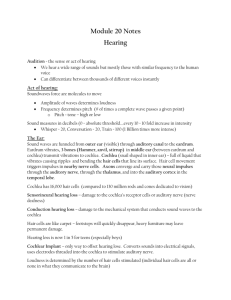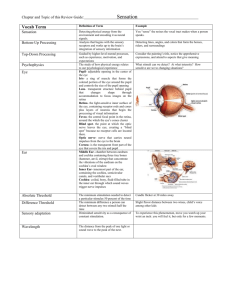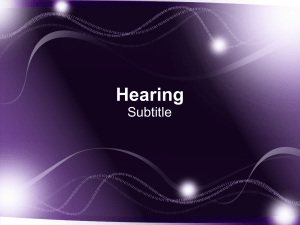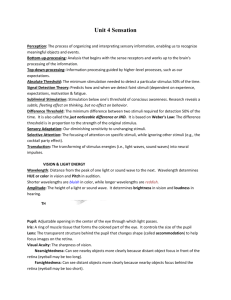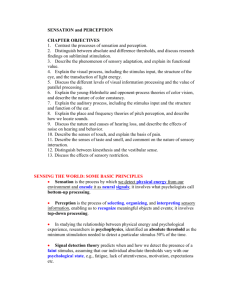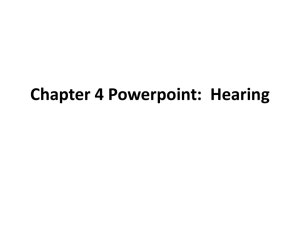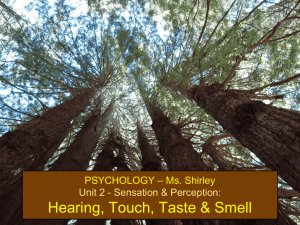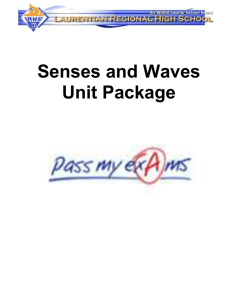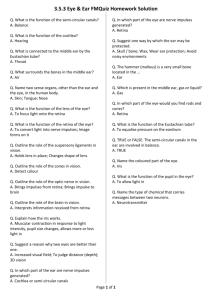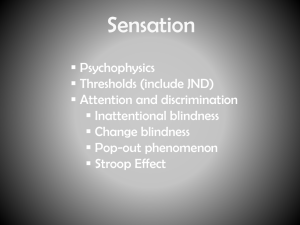Sensation Review
advertisement
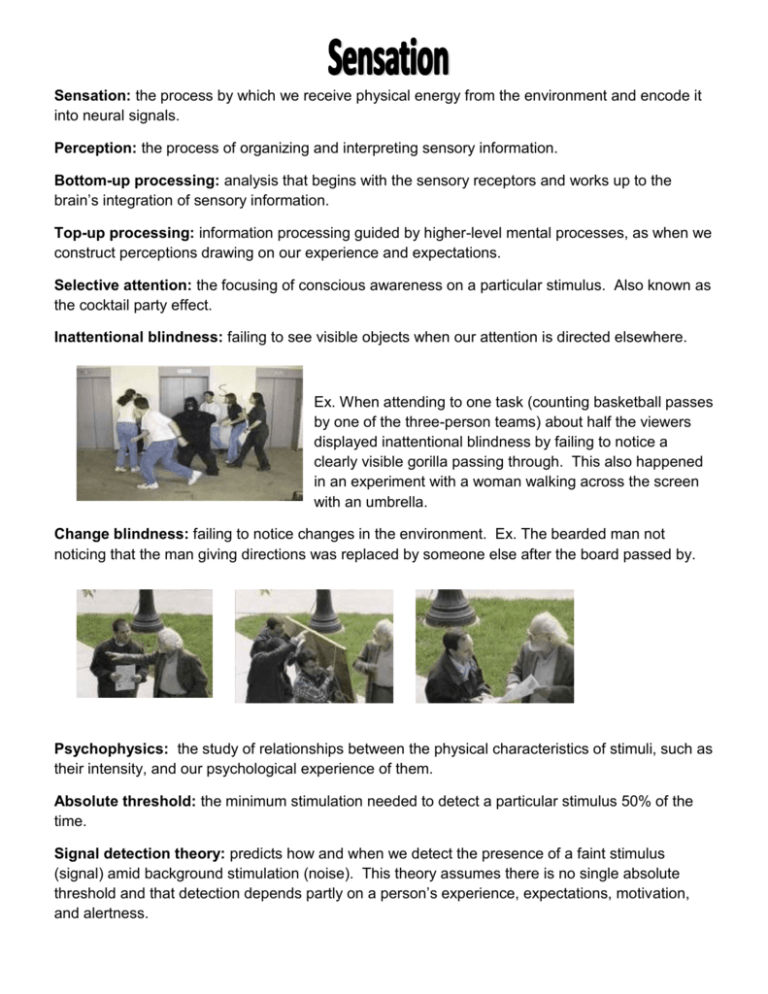
Sensation: the process by which we receive physical energy from the environment and encode it into neural signals. Perception: the process of organizing and interpreting sensory information. Bottom-up processing: analysis that begins with the sensory receptors and works up to the brain’s integration of sensory information. Top-up processing: information processing guided by higher-level mental processes, as when we construct perceptions drawing on our experience and expectations. Selective attention: the focusing of conscious awareness on a particular stimulus. Also known as the cocktail party effect. Inattentional blindness: failing to see visible objects when our attention is directed elsewhere. Ex. When attending to one task (counting basketball passes by one of the three-person teams) about half the viewers displayed inattentional blindness by failing to notice a clearly visible gorilla passing through. This also happened in an experiment with a woman walking across the screen with an umbrella. Change blindness: failing to notice changes in the environment. Ex. The bearded man not noticing that the man giving directions was replaced by someone else after the board passed by. Psychophysics: the study of relationships between the physical characteristics of stimuli, such as their intensity, and our psychological experience of them. Absolute threshold: the minimum stimulation needed to detect a particular stimulus 50% of the time. Signal detection theory: predicts how and when we detect the presence of a faint stimulus (signal) amid background stimulation (noise). This theory assumes there is no single absolute threshold and that detection depends partly on a person’s experience, expectations, motivation, and alertness. Subliminal: below one’s absolute threshold for conscious awareness. Priming: the activation, often unconsciously, of certain associations, thus predisposing one’s perception, memory, or response. Difference threshold: the minimum difference between two stimuli required for detection 50% of the time. We experience this difference threshold as a just noticeable difference (jnd). Weber’s law: the principle that, to be perceived as different, two stimuli must differ by a constant percentage (rather than a constant amount). Sensory adaptation: diminished sensitivity as a consequence of constant stimulation. Ex. hot tub no longer feeling hot because you have gotten “used” to it. Transduction: the conversion of one form of energy into another. In sensation, this is the transformation of sights, sounds, and smells into neural impulses our brain can interpret. Wavelength: the distance from the peak of one light or sound wave to the next peak. Wavelengths in light waves determine the hue (color) and wavelengths in sound waves determine the pitch (sound). Amplitude: the wave’s height. It is measured from the peak of the wave to the trough of the wave. Amplitude measures the intensity of the wave. In light it determines the brightness of the color and in sound it determines the volume. Vision: the sense of sight. Pupil: the adjustable opening in the center of the eye through which light enters. Iris: the ring of muscle tissue that forms the colored portion of the eye and that controls the size of the pupil opening. Lens: the transparent structure behind the pupil that changes shape to help focus images on the retina. This process of the lens changing shape is called accommodation. Retina: the light-sensitive inner surface of the eye that contains the receptor rods and cones plus layers of neurons that begin the processing of transduction for vision. Rods: retinal receptors that detect black, white, and shades of gray that are necessary for peripheral and twilight vision when cones don’t respond. The human eye has around 120 million rods. Cones: retinal receptors that are concentrated near the center of the retina that detect colors and details and that function in the daylight or in well-lit conditions. The human eye has around 6 million cones. Fovea: the central focal point in the retina, around which the eye’s cones cluster. Optic nerve: the nerve that carries neural impulses from the eye to the brain. Blind spot: the point at which the optic nerve leaves the eye, creating a “blind’ spot because there are no receptor cells located there. The process of transduction: Bipolar cells: specialized neurons that connect the rods and cones w/the ganglion cells. Ganglion cells: specialized neurons that connect to the bipolar cells. The bundled axons of the ganglion cells form the optic nerve. Feature Detectors: nerve cells in the brain that respond to specific features of the stimulus, such as shape, angle, or movement. Parallel processing: the brain’s natural mode of information processing many things at once, such as color, motion, form, and depth. Young-Helmholtz trichromatic (three-color) theory: the theory that the retina contains three different color receptors (red, green, and blue) which, when stimulated in combination can produce the perception of any color. Opponent-process theory: the theory that opposing retinal processes (red-green, yellow-blue, white-black) enable color vision. This explains the afterimage effect (staring at a yellow, green, and black flag and when looking away, you see red, white, and blue). Acuity: sharpness of vision. Nearsightedness: a condition in which nearby objects are seen clearly but distant objects are blurred because light rays reflecting from them converge in front of the retina. Farsightedness: a condition in which distant objects are seen clearly but nearby objects are blurred because light rays reflecting from them strike the retina before converging. Audition: the sense of hearing. Frequency: the number of complete wavelengths that pass a point in a given time. Frequency determines the pitch. Pitch: a tone’s highness or lowness. The shorter the waves, the higher the pitch; the longer the waves, the lower the pitch. Amplitude: the strength of a wave. This is measured from peak to trough. The taller the wave, the louder the sound; the shorter the wave, the softer the sound. Timbre: the sound of a tone. It allows you to distinguish between two similar sounds. Ex. Hearing the difference between a flute and a piccolo. Outer ear: the part of the ear that traps sound waves and channels them through the auditory canal to the eardrum. Pinna: the fleshy outside part of the ear. Auditory canal: the canal in the outer part of the ear down which sound waves travel. At the end of the auditory canal is the eardrum. Eardrum: the tight membrane that vibrates when sound waves hit it. Middle ear: the part of the ear that transmits the eardrum’s vibrations through a piston made of three tiny bones (hammer, anvil, and stirrup) to the cochlea. Inner ear: the innermost part of the ear that contains the cochlea, semicircular canals, and vestibular sacs (important for balance). This is where transduction happens for sound. Basilar membrane: A membrane inside the cochlea which vibrates in response to sound and whose vibrations lead to activity in the auditory pathways. Auditory nerve: the nerve that sends neural messages (via the thalamus) to the temporal lobe’s auditory cortex. Pinna Place theory: links pitch we hear with the place where the cochlea’s membrane is stimulated. This theory can explain how we high-pitched sounds, but now how we hear low-pitch sounds because the neural signals generated by low-pitched sounds are not so neatly localized on the basilar membrane. Frequency theory: states that the rate of nerve impulses traveling up the auditory nerve matches the frequency of a tone, thus enabling us to sense its pitch. Volley principle: neural cells alternate firing. By firing in rapid succession, they can achieve a combined frequency. Conduction hearing loss: hearing loss caused by damage to the mechanical system, such as the three bones, that conducts sound waves to the cochlea. A hearing aid may help amplify sounds for someone who has conduction hearing loss. Sensorineural hearing loss: hearing loss caused by damage of the cochlea’s receptor cells or to the auditory nerves. It is also called nerve deafness. This can be caused by disease, but are more often the culprits of biological changes linked heredity, aging, and prolonged exposure to earsplitting noise or music. Cochlear implant: a device for converting sounds into electrical signals and stimulating the auditory nerve through electrodes threaded into the cochlea. Epidermis: the outside layer of skin. Dermis: the inside layer of skin. Gate-control theory: the theory that the spinal cord contains a neurological “gate” that blocks pain signals or allows them to pass on to the brain. The “gate” is opened by the activity of pain signals traveling up small nerve fibers and is closed by activity in larger fibers or by information coming from the brain. Phantom limb sensations: feeling sensations or movement in limbs that have been removed. Tinnitus: a phantom auditory sensation in which people hear ringing in the ears. Nociceptors: sensory receptors that detect hurtful temperatures, pressure, or chemicals. Endorphins: the body’s natural painkillers. Gustation: the sense of taste. There are 5 basic tastes: sweet, salty, sour, bitter, and umami (taste of meat). Papillae: structures on the tongue in which the taste buds are located. Sensory interaction: the principle that one sense may influence another, as when the smell of food influences its taste. McGurk effect: a perceptual phenomenon which demonstrates an interaction between hearing and vision in speech perception. This effect may be experienced when a video of one phoneme's production is dubbed with a sound-recording of a different phoneme being spoken. Often, the perceived phoneme is a third, intermediate phoneme. For example, a visual /ga/ combined with an audio /ba/ is often heard as /da/. Olfaction: the sense of smell. *Remember: an old factory smells bad. Odorants: a chemical compound that has smell. Olfactory bulb: the place in the nasal cavity where transduction occurs for smell. *Remember that smell does not go to the thalamus. It goes directly to the amygdala and then the hippocampus. Bad smells make people angry and smells make strong memories. Vestibular sense: the sense of body movements and position, including the sense of balance. Kinesthesis: the system for sensing the position and movement of individual body parts. Proprioceptors: sensors that are located in the skin, joints, muscles, and tendons for kinethesis.
